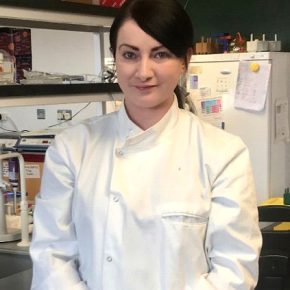Radiation Response in Oesophageal Cancer: the role of visceral fat tissue in controlling response through immune-metabolic regulation

Fiona O’Connell
Oesophageal cancer is cancer of the oesophagus, the pipe connecting the mouth to the stomach. It is an aggressive disease, the occurrence of which is expected to double in the next twenty years with increasing obesity rates in Ireland and worldwide.
Oesophageal cancer is the cancer that is most highly associated with obesity. This project is focused on finding out the link between obesity and oesophageal cancer and its response to radiation therapy. The aim of Fiona’s project is to look at how obesity affects the response of the immune system by looking at how adipose (fat) tissue taken from obese and non-obese patients affects how different cells from the immune system grow and work.
Her project will then look at whether healthy dietary fats affect how the immune system responds to radiation treatment and if these fats could be used to change how the immune system responds to radiation treatment.
At the end of this project, a profile should be developed that shows a different signature for patients who will respond to radiation therapy and those who won’t respond to radiation therapy as well as how obesity will affect the response to radiation. This is a patient-focused project that aims to have a significant impact on Oesophageal cancer patients response to treatment prior to surgery. Our findings will allow a better understanding of events controlling treatment response and resistance in oesophageal cancer patients.
To find out more about this project, please see the short video below:
Research Findings
Publications
O’Connell F, Mylod E, Donlon NE, Heeran AB, Butler C, Bhardwaj A, Ramjit S, Durand M, Lambe G, Tansey P, Welartne I, Sheahan KP, Yin X, Donohoe CL, Ravi N, Dunne MR, Brennan L, Reynolds JV, Roche HM, O’Sullivan J. Energy Metabolism, Metabolite, and Inflammatory Profiles in Human Ex Vivo Adipose Tissue Are Influenced by Obesity Status, Metabolic Dysfunction, and Treatment Regimes in Patients with Oesophageal Adenocarcinoma. Cancers (Basel). 2023 Mar 9;15(6):1681. doi: 10.3390/cancers15061681. PMID: 36980567; PMCID: PMC10046380.
Donlon NE, Davern M, O’Connell F, Sheppard A, Heeran A, Bhardwaj A, Butler C, Narayanasamy R, Donohoe C, Phelan JJ, Lynam-Lennon N, Dunne MR, Maher S, O’Sullivan J, Reynolds JV, Lysaght J. Impact of radiotherapy on the immune landscape in oesophageal adenocarcinoma. World J Gastroenterol. 2022 Jun 7;28(21):2302-2319. doi: 10.3748/wjg.v28.i21.2302. PMID: 35800186; PMCID: PMC9185220.
Essa N, O’Connell F, Prina-Mello A, O’Sullivan J, Marcone S. Gold nanoparticles and obese adipose tissue microenvironment in cancer treatment. Cancer Lett. 2022 Jan 28;525:1-8. doi: 10.1016/j.canlet.2021.10.017. Epub 2021 Oct 15. PMID: 34662546.
Donlon NE, Davern M, Sheppard AD, O’Connell F, Dunne MR, Hayes C, Mylod E, Ramjit S, Temperley H, Mac Lean M, Cotter G, Bhardwaj A, Butler C, Conroy MJ, O’Sullivan J, Ravi N, Donohoe CL, Reynolds JV, Lysaght J. The Impact of Esophageal Oncological Surgery on Perioperative Immune Function; Implications for Adjuvant Immune Checkpoint Inhibition. Front Immunol. 2022 Jan 27;13:823225. doi: 10.3389/fimmu.2022.823225. PMID: 35154142; PMCID: PMC8829578.
Mylod E, O’Connell F, Donlon NE, Butler C, Reynolds JV, Lysaght J, and Conroy MJ. The Omentum in Obesity-Associated Cancer: A Hindrance to Effective Natural Killer Cell Migration towards Tumour Which Can Be Overcome by CX3CR1 Antagonism. Cancers 2022, 14(1), 64; https://doi.org/10.3390/cancers14010064
O’Connell F, O’Sullivan J. Help or hindrance: The obesity paradox in cancer treatment response. Cancer Lett. 2021 Dec 1;522:269-280. doi: 10.1016/j.canlet.2021.09.021. Epub 2021 Sep 15. PMID: 34534616. https://pubmed.ncbi.nlm.nih.gov/34534616/
Essa N, O’Connell F, Prina-Mello A, O’Sullivan J, Marcone S. Gold nanoparticles and obese adipose tissue microenvironment in cancer treatment. Cancer Lett. 2021 Oct 15:S0304-3835(21)00528-0. doi: 10.1016/j.canlet.2021.10.017. Epub ahead of print. PMID: 34662546. https://pubmed.ncbi.nlm.nih.gov/34662546/
Donlon NE, Davern M, Sheppard A, Power R, O’Connell F, Heeran AB, King R, Hayes C, Bhardwaj A, Phelan JJ, Dunne MR, Ravi N, Donohoe CL, O’Sullivan J, Reynolds JV, Lysaght J. The Prognostic Value of the Lymph Node in Oesophageal Adenocarcinoma; Incorporating Clinicopathological and Immunological Profiling. Cancers (Basel). 2021 Aug 9;13(16):4005. doi: 10.3390/cancers13164005. PMID: 34439160; PMCID: PMC8391676. https://pubmed.ncbi.nlm.nih.gov/34439160/
Kennedy SA, Morrissey ME, Dunne MR, O’Connell F, Butler CT, Cathcart MC, Buckley AM, Mehigan BJ, Larkin JO, McCormick P, Kennedy BN, O’Sullivan J. Combining 1,4-dihydroxy quininib with Bevacizumab/FOLFOX alters angiogenic and inflammatory secretions in ex vivo colorectal tumors. BMC Cancer. 2020 Oct 2;20(1):952. doi: 10.1186/s12885-020-07430-y. PMID: 33008336; PMCID: PMC7532092. doi: 10.1186/s12885-020-07430-y
Slater K, Heeran AB, Garcia-Mulero S, Kalirai H, Sanz-Pamplona R, Rahman A, Al-Attar N, Helmi M, O’Connell F, Bosch R, Portela A, Villanueva A, Gallagher WM, Jensen LD, Piulats JM, Coupland SE, O’Sullivan J, Kennedy BN. High Cysteinyl Leukotriene Receptor 1 Expression Correlates with Poor Survival of Uveal Melanoma Patients and Cognate Antagonist Drugs Modulate the Growth, Cancer Secretome, and Metabolism of Uveal Melanoma Cells. Cancers (Basel). 2020 Oct 13;12(10):2950. doi: 10.3390/cancers12102950. PMID: 33066024; PMCID: PMC7600582.. doi: 10.3390/cancers12102950
Cahill C, O’Connell F, Gogan KM, Cox DJ, Basdeo SA, O’Sullivan J, Gordon SV, Keane J, Phelan JJ. The Iron Chelator Desferrioxamine Increases the Efficacy of Bedaquiline in Primary Human Macrophages Infected with BCG. Int J Mol Sci. 2021 Mar 13;22(6):2938. doi: 10.3390/ijms22062938. PMID: 33805837; PMCID: PMC8001338.
Donlon NE, Davern M, Sheppard A, Power R, O’Connell F, Heeran AB, King R, Hayes C, Bhardwaj A, Phelan JJ, Dunne MR, Ravi N, Donohoe CL, O’Sullivan J, Reynolds JV, Lysaght J. The Prognostic Value of the Lymph Node in Oesophageal Adenocarcinoma; Incorporating Clinicopathological and Immunological Profiling. Cancers (Basel). 2021 Aug 9;13(16):4005. doi: 10.3390/cancers13164005. PMID: 34439160; PMCID: PMC8391676.
Cahill C, Cox DJ, O’Connell F, Basdeo SA, Gogan KM, Ó’Maoldomhnaigh C, O’Sullivan J, Keane J, Phelan JJ. The Effect of Tuberculosis Antimicrobials on the Immunometabolic Profiles of Primary Human Macrophages Stimulated with Mycobacterium tuberculosis. Int J Mol Sci. 2021 Nov 10;22(22):12189. doi: 10.3390/ijms222212189. PMID: 34830070; PMCID: PMC8624646.
Malebari AM, Fayne D, Nathwani SM, O’Connell F, Noorani S, Twamley B, O’Boyle NM, O’Sullivan J, Zisterer DM, Meegan MJ. β-Lactams with antiproliferative and antiapoptotic activity in breast and chemoresistant colon cancer cells. Eur J Med Chem. 2020 Mar 1;189:112050. doi: 10.1016/j.ejmech.2020.112050. Epub 2020 Jan 10. PMID: 31954879.
Donlon NE, Sheppard A, Davern M, O’Connell F, Phelan JJ, Power R, Nugent T, Dinneen K, Aird J, Greene J, Nevins Selvadurai P, Bhardwaj A, Foley EK, Ravi N, Donohoe CL, Reynolds JV, Lysaght J, O’Sullivan J, Dunne MR. Linking Circulating Serum Proteins with Clinical Outcomes in Esophageal Adenocarcinoma-An Emerging Role for Chemokines. Cancers (Basel). 2020 Nov 13;12(11):3356. doi: 10.3390/cancers12113356. PMID: 33202734; PMCID: PMC7698106.
Slater K, Bosch R, Smith KF, Jahangir CA, Garcia-Mulero S, Rahman A, O’Connell F, Piulats JM, O’Neill V, Horgan N, Coupland SE, O’Sullivan J, Gallagher WM, Villanueva A, Kennedy BN. 1,4-dihydroxy quininib modulates the secretome of uveal melanoma tumour explants and a marker of oxidative phosphorylation in a metastatic xenograft model. Front Med (Lausanne). 2023 Jan 9;9:1036322. doi: 10.3389/fmed.2022.1036322. PMID: 36698840; PMCID: PMC9868667.
Back









 Contact
Contact